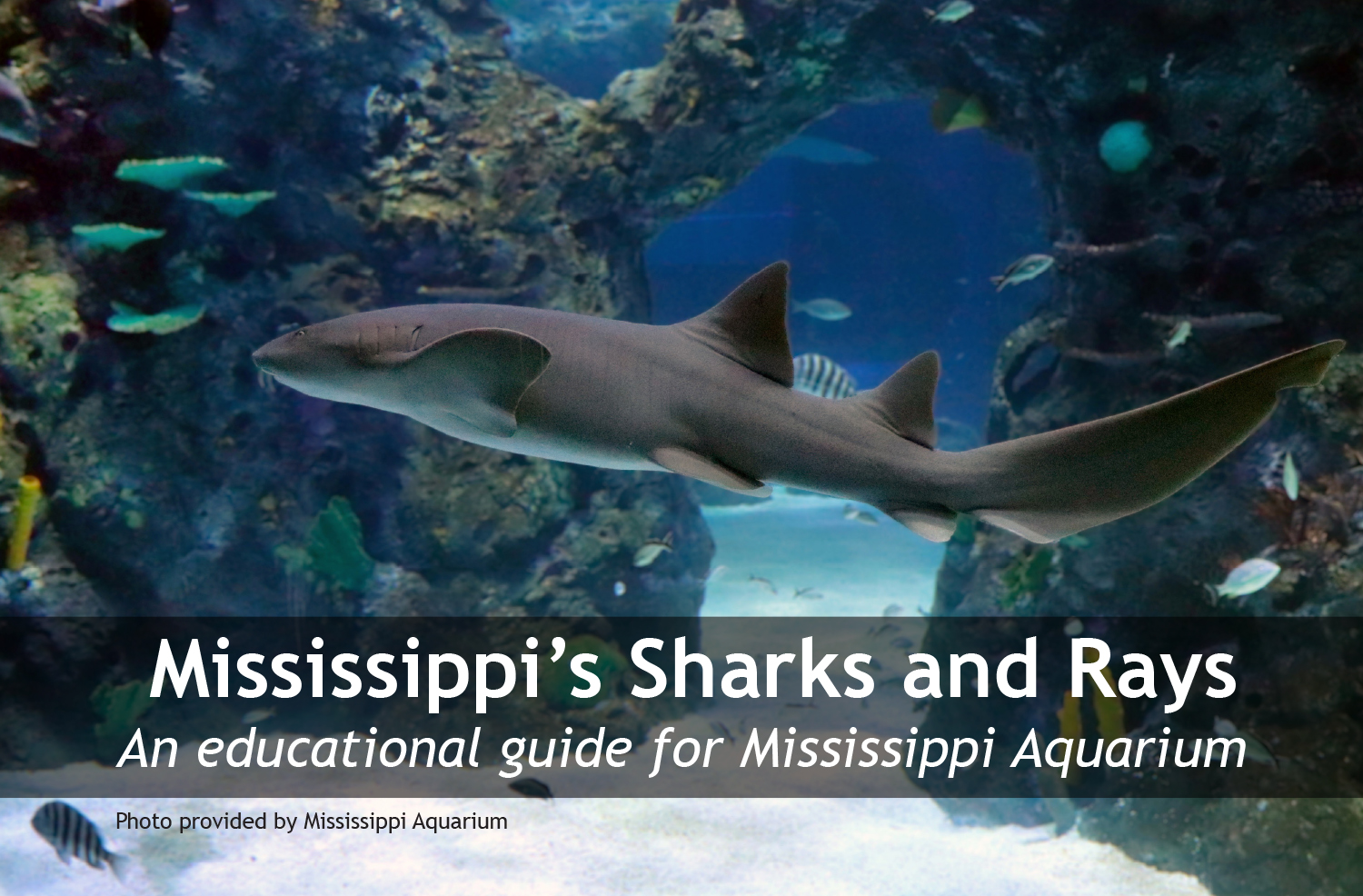Mississippi’s Sharks and Rays
An educational guide for Mississippi Aquarium

Edited by Marcus Drymon, PhD1,2
Illustrations by Bryan Huerta-Beltran1
Species data compiled by Matthew Jargowsky1,2 and Emily Seubert1
1Mississippi State University Extension Service
2Mississippi-Alabama Sea Grant Consortium
MASGP-21-016
Using This Guide

The waters surrounding Mississippi are home to an exciting diversity of sharks, skates, and rays (collectively called elasmobranchs). We’ve developed this book to showcase a small portion of this diversity and highlight the sharks and rays you may see at Mississippi Aquarium. Below are a few things to keep in mind as you go through this book. First, we’ve included the common and Latin (or scientific) name for each species. Then, alongside each color illustration, we’ve shown an example of a single tooth from the upper jaw (sharks) or an entire set of jaws (rays). We’ve also described the average size at maturity (i.e., size at adulthood) and the maximum reported total length (for sharks) or disc width (“wingspan,” for rays) for Gulf of Mexico specimens. To best illustrate the maximum reported total length of each shark and the maximum reported disc width of each ray, we’ve displayed a silhouette of each species relative to a 6-foot-tall human. Finally, we’ve presented a color-coded “population status” graphic to indicate whether the current status of each population is good (green), fair (yellow), poor (red), or unknown (gray). To develop this graphic, we used data from NOAA Fisheries for populations in the U.S. Gulf of Mexico, instead of the IUCN, which provides global population trends. While current as of 2021, it’s important to remember that the statuses of U.S. shark and ray populations are constantly changing (hopefully for the better!).
We hope this book increases your appreciation for the incredible diversity of sharks and rays off our coast. Enjoy!
Anatomy of a Shark

Anatomy of a Ray

Mississippi Aquarium Sharks
Nurse shark
Ginglymostoma cirratum

- Nasal barbels (slender, whisker-like sensory organs)
- Wide head, giving it a tadpole-like appearance
- First dorsal fin farther back on body

Size: 6 ft 7 in (at maturity), 9 ft (max)
Habitat & Diet: Shallow coastal waters; feeds on fishes and invertebrates Interesting Fact: Coloration ranges from yellowish tan to dark brown
Sandbar shark
Carcharhinus plumbeus

- Snout shorter than mouth width
- Large first dorsal fin
- Interdorsal ridge

Size: 6 ft (at maturity), 7 ft 8 in (max)
Habitat & Diet: Coastal waters; feeds on small fishes
Interesting Fact: Undertakes long seasonal migrations
Sand tiger shark
Carcharias taurus

- Sharp, jagged teeth
- First dorsal fin located far back on body
- Secondary dorsal fin nearly as large as first dorsal fin

Size: 6 ft 7 in (at maturity), 9 ft 10 in (max)
Habitat & Diet: Shallow water, often found near bottom; feeds on fishes Interesting Fact: Siblings eat each other in the womb (termed adelphophagy)
Common Mississippi Sharks
Atlantic sharpnose shark
Rhizoprionodon terraenovae

- Well-pronounced labial furrows (grooves around the mouth)
- White spots (adults only)
- Pre-anal ridges

Size: 2 ft 6 in (at maturity), 3 ft 7 in (max)
Habitat & Diet: Inshore and offshore; feeds on small fishes and invertebrates Interesting Fact: Most common coastal shark in the northern Gulf of Mexico
Blacknose shark
Carcharhinus acronotus

- Black-tipped nose
- Large eyes
- Copper color along body

Size: 3 ft 5 in (at maturity), 5 ft (max)
Habitat & Diet: Shallow, warm coastal waters; feeds on small fishes
Interesting Fact: Sometimes mistaken for a lemon shark because of its color
Blacktip shark
Carcharhinus limbatus

- Nose shorter than mouth width
- Stout body
- Black tips on all fins except anal fin

Size: 4 ft 8 in (at maturity), 6 ft 3 in (max)
Habitat & Diet: Nearshore, subtropical coastal waters; feeds on fishes
Interesting Fact: Often seen with a species-specific parasite on dorsal region
Mississippi Apex Predators
Bull shark
Carcharhinus leucas

- Short, blunt snout
- Small eyes
- Stocky body

Size: 7 ft 5 in (at maturity), 9 ft 4 in (max)
Habitat & Diet: Coastal waters, including freshwater; feeds on fishes, stingrays, and sharks
Interesting Fact: Juveniles prefer estuaries and rivers; adults inhabit saltwater
Tiger shark
Galeocerdo cuvier

- Short, blunt snout
- Dorsal surface covered with dark spots/bands
- Well developed caudal keel

Size: 9 ft 10 in (at maturity), 15 ft (max)
Habitat & Diet: Subtropical and tropical waters; feeds on sea turtles, mammals, fishes, and sharks
Interesting Fact: Teeth distinctly curved and serrated for tearing through prey
Shortfin mako
Isurus oxyrinchus

- Conical snout
- Blue color along body
- Lunate tail

Size: 6 ft 6 in (at maturity), 13 ft (max)
Habitat & Diet: Subtropical and tropical waters; feeds on fishes and squids
Interesting Fact: Considered the fastest shark in the ocean (nearly 40 mph)
Mississippi Hammerheads
Bonnethead
Sphyrna tiburo

- Flattened, shovel-shaped head
- Speckles on body
- Brownish or greenish-gray color

Size: 2 ft 4 in (at maturity), 5 ft (max)
Habitat & Diet: Shallow inshore waters; feeds mostly on small invertebrates
Interesting Fact: Teeth are specially modified molars for consuming crabs
Scalloped hammerhead
Sphyrna lewini

- Notches near eyes on head (cephalofoil)
- Pelvic fins with straight rear margins
- Long and low secondary dorsal fin

Size: 6 ft 7 in (at maturity), 11 ft 6 in (max)
Habitat & Diet: Coastal and oceanic waters; feeds on stingrays, fishes, and small sharks
Interesting Fact: Sometimes swim on their sides
Great hammerhead
Sphyrna mokarran

- Nearly straight head (cephalofoil)
- Extremely high, curved (i.e., falcate) first dorsal fin
- Pelvic fins with curved rear margins

Size: 10 ft (at maturity), 16 ft (max)
Habitat & Diet: Shallow coastal waters; feeds on stingrays, smaller sharks, and fishes
Interesting Fact: The largest hammerhead species in the world
Mississippi Deepwater Sharks
Gulper shark
Centrophorus granulosus

- Green eyes
- Spines on each dorsal fin
- No anal fin

Size: 3 ft 2 in (at maturity), 4 ft 6 in (max)
Habitat & Diet: Deep waters; feeds on small fishes and squids
Interesting Fact: Large, broad, leaf-like scales (known as dermal denticles)
Sharpnose sevengill shark
Heptranchias perlo

- Narrow, tapering snout
- Seven gill slits
- Only one dorsal fin, located far back on body

Size: 2 ft 10 in (at maturity), 3 ft 8 in (max)
Habitat & Diet: Deep, subtropical and warm waters; feeds on squids and small fishes
Interesting Fact: Most shark species have five gill slits, but this species has seven
Goblin shark
Mitsukurina owstoni

- Long, blade-like snout
- Jaws that can extend outward for prey capture
- Long caudal fin that lacks a lower lobe

Size: Size at maturity unknown; estimates suggest 16 ft as max size
Habitat & Diet: Deep waters; feeds on fishes, squids, and crustaceans
Interesting Fact: Monotypic (the only species in its family)
Mississippi Aquarium Rays
Cownose ray
Rhinoptera bonasus

- Wide head
- Fleshy “cephalic” lobes used for prey capture
- One to two stings at base of tail

Size: 2 ft 1 in (at maturity), 3 ft 11 in (max)
Habitat & Diet: Shallow coastal waters; feeds on bivalves, crustaceans, and marine worms
Interesting Fact: Seasonally migrates in schools of up to 10,000 in the Gulf
Atlantic stingray
Hypanus sabinus

- Pointed snout
- Well developed pelvic fins
- Row of small thorns

Size: 10 in (at maturity), 2 ft (max)
Habitat & Diet: Coastal waters, including freshwater; feeds on small invertebrates and fishes
Interesting Fact: Only U.S. shark/ray with permanent freshwater populations (Florida)
Southern stingray
Hypanus americanus

- Diamond-shaped body
- Well developed ventral tail fold
- Poorly developed dorsal tail fold

Size: 2 ft 6 in (at maturity), 5 ft (max)
Habitat & Diet: Nearshore and coastal waters; feeds on crustaceans and fishes
Interesting Fact: Tourists often swim with this species when visiting the Caribbean
Other Mississippi Rays
Bluntnose stingray
Hypanus say

- Blunt snout
- Well developed ventral tail fold
- Well developed dorsal tail fold

Size: 1 ft 7 in (at maturity), 2 ft 7 in (max)
Habitat & Diet: Shallow coastal waters; feeds on crustaceans and fishes
Interesting Fact: Frequently has up to three stings
Smooth butterfly ray
Gymnura lessae

- Wide pectoral fins
- No sting
- Short tail

Size: 1 ft 7 in (at maturity), 4 ft (max)
Habitat & Diet: Coastal waters; feeds on fishes
Interesting Fact: Ambush predator that uses its pectoral fins to strike and stun fish prey
Lesser electric ray
Narcine bancroftii

- Kidney-shaped electric organs
- Dark ring-like markings
- Two tall dorsal fins

Size: 11 in (at maturity), 2 ft 1 in (max)
Habitat & Diet: Shallow coastal waters; feeds on marine worms
Interesting Fact: Can generate up to 56 volts of electricity, which it uses for defense
Conservation and Management
The individuals included in this guide are only a portion of the diverse shark and ray species that live off the Mississippi coast. In spite of their many sizes, shapes, and colors, most sharks and rays share a similar set of biological characteristics that include slow growth, late age at maturity, and long lifespan. Unfortunately, these “life history” characteristics mean that once depleted, it can be difficult for shark and ray populations to recover.
Overharvest, habitat loss, and pollution are some of the threats currently facing sharks and rays. Collecting baseline life history data is the first step toward managing and conserving these species. Fortunately, Mississippi Aquarium has partnered with researchers at Mississippi State University to help fill some of the data gaps for local sharks and rays. Research partnerships like this one are critical to ensuring the future sustainability of the sharks and rays that call Mississippi home.



This guide was funded in part by Mississippi Aquarium.
Publication 3650 (06-21)
Copyright 2021 by Mississippi State University. All rights reserved. This publication may be copied and distributed without alteration for nonprofit educational purposes provided that credit is given to the Mississippi State University Extension Service.
The Mississippi State University Extension Service is working to ensure all web content is accessible to all users. If you need assistance accessing any of our content, please email the webteam or call 662-325-2262.



